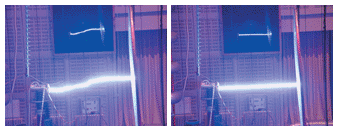
|
Terawatt pulses probe air
|
|
HIGH-ENERGY
LASERS
|
|
Pulsed-laser-induced white-light generation in
air is becoming an important tool for atmospheric
studies. Applying time and spectrally resolved
analysis to the backscatter data allows the remote
sensing of many different atmospheric molecules at
the same time (see Laser Focus World, November
1999, p. 36); in addition, highly intense light
pulses create conductive channels that can be
studied with respect to their lightning-conduction
capabilities.
|
|
Lidar (light detection and ranging) applications
of pulsed-laser-induced white-light generation in
air were first demonstrated by a team of different
German laboratories.1 In 1999, a
German-French research project, the Teramobile
project, was established, involving the Freie
Universität (Berlin, Germany), the
Friedrich-Schiller-Universität (Jena,
Germany), the Université Claude Bernard
(Lyon, France), and the Laboratoire Ondes et
Acoustique (Palaiseau, France). In addition to
other achievements, the setup of a mobile terawatt
laser (the Teramobile) and associated laboratory
experiments have been completed.2, 3, 4
|

Laser pulses with terawatt-level peak power
create a conductive pathway in air, guiding an
artificially created lightning flash in a
laboratory. An unguided flash takes a zigzag
pathway (left), while a laser-guided flash takes a
straight line (right).
Optical breakdown with isotropic white-light
emission occurs at the focus of energetic laser
pulses. However, the formation of white-light
filaments in self-guided channels in air has become
possible only with the generation of laser pulses
of ultrahigh peak power emitted by femtosecond
lasers. White-light generation is believed to
originate predominantly from self-phase modulation.
Self-focusing is due to the optical Kerr effect,
becoming effective in air when the pulse intensity
exceeds 1010W/cm2. It is
balanced by diffraction and refraction from the
diluted plasma, which is initiated at radiation
intensities above 1013 W/cm2.
|
|
White-light filaments have been observed to be
stable over tens of meters and can be initiated at
a chosen distance from the emitting laser. The
distance can be controlled by setting a pre-chirp
of the laser so that group velocity dispersion
becomes compensated when the pulse has traveled the
chosen length. The spectral continuum generated by
near-infrared terawatt pulses in air had been found
to extend from 900 to 1500 nm; recently its
extension into the mid-infrared up to 4.5 µm
was observed. Thus, it is possible to speak of the
emitted light, which propagates collinearly with
the original laser beam, as a supercontinuum (SC).
|
|
For atmospheric investigations, a laboratory
100-fs, 220-mJ Ti:sapphire laser system emitting at
790 nm was used to make remote-sensing absorption
measurements. Water vapor and oxygen were measured
up to a height of about 800 m when positioning the
SC generation zone at an altitude of 150 m. Using
the mid-infrared portion of the SC, remote sensing
is now possible for infrared-absorbing species such
as hydrocarbons.
|
|
A test of the Teramobile
The Teramobile was completed early in 2001. It is a
Ti:sapphire laser system supplying 6-TW pulses of
70-fs duration centered at a 790-nm wavelength. The
pulse energy is 350 mJ, while the repetition rate
is 10 Hz. Femtosecond generation is performed by
modelocking and the energy is amplified by chirp
pulse amplification. The Teramobile laser system
uses a regenerative amplifier and two multipass
amplifiers.
|
|
The laser system—including power supply,
operating panel, and signal-processing
electronics—weighs 9.5 tons and fits within a
standard freight container of 6 x 2.5-m footprint.
The first atmospheric lidar measurements using the
Teramobile are to be performed late this year in
cooperation with an astronomical observatory in
Tautenburg, Germany. The first horizontal
atmospheric measurements were already performed in
spring 2001.5
|
|
One potential application of lasers like the
Teramobile is in lightning control. An experiment
was held at the Technical University (Berlin,
Germany) with the Teramobile in which lightning
strikes were guided by the laser beam.6
The laser was set to emit 240-mJ pulses of 260-fs
duration, with a peak power of 0.92 TW. Impressive
results were obtained (see figure). The distance
between the Teramobile container and the first
high-voltage electrode was 20 m; the electrode gap
was set at 2.5 m. The voltage necessary to ignite
the unguided flash was 2.25 MV (negative polarity),
which dropped to 1.6 MV when the laser beam was
directed across the gap. Much longer electrically
conductive filaments created in the atmosphere
could someday guide lightning controllably and
safely to a specified location.
|
|
Uwe Brinkmann
|
|
REFERENCES
- L. Wöste et al., Laser u.
Optoelektronik 29 (5), 51 (1997).
- J. Yu et al., Opt. Lett. 26 (8), 533 (2001).
- J. Kasparian et al., Opt. Lett. 25 (18),
1397 (2000).
- P. Rairoux et al., Appl. Phys. B 71, 573
(2000).
- H. Wille et al., "Teramobile: a Mobile
Femtosecond-Terawatt Laser and Detection
System," Europ. Phys. J. D, to be published
2001.
- M. Rodriguez et al., "High Voltage Discharge
Triggering and Guiding by Ultrashort Laser
Filamentation," to be published 2001.
|
|
Laser Focus World January, 2002
Author(s) : Uwe Brinkmann
|
|